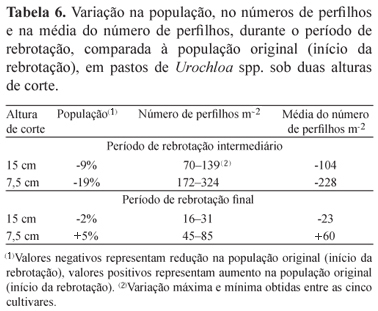The objective of this work was to evaluate structural and morphogenetic responses of two species and five cultivars of brachiaria to defoliation intensities. The cultivars Marandu, Xaraés, Arapoty, Capiporã (Urochloa brizantha), and Basilisk (U. decumbens) were mechanically defoliated at 15 and 7.5 cm, in mid-summer and mid-winter. The experimental units (9x4 m plots) were irrigated and fertilized with 220 kg ha-1 per year of N and K2O. Morphogenetic characteristics measured were: phyllochron, leaf senescence and life span, and leaf appearance and elongation rate. The structural characteristics evaluated were: number of leaves per tiller, final leaf length of fully expanded leaves, stems length, senescence/growth ratio, and tiller density. Variations in meteorological conditions of each season promoted increasing of the appearance rates and leaf elongation, and decreasing of the phyllochron and leaf life span. The structural features most responsive to the gradient promoted by harvesting heights were the final leaf length of expanded leaves and tiller density. The lower harvest height had the greatest impact on growth dynamics in comparison to senescence, in individual tillers. The cultivars Xaraés and Capiporã were more productive due to higher leaf elongation rates and higher tiller density.
Brachiaria; Urochloa; tissue flows; defoliation management; morphogenesis; senescence






